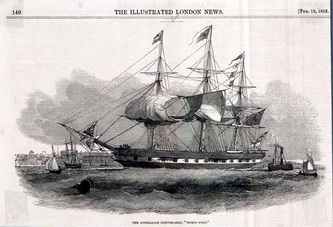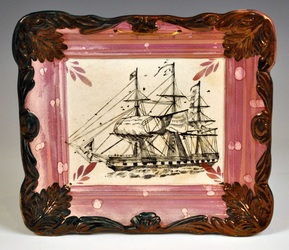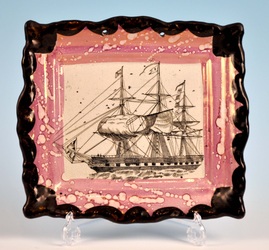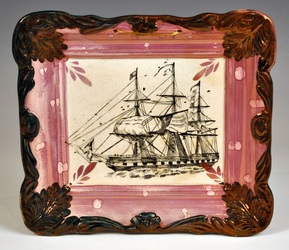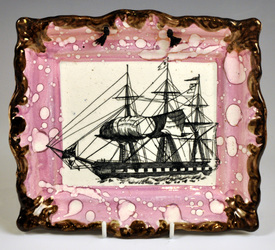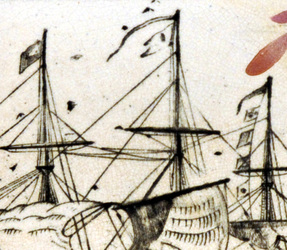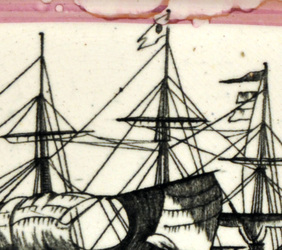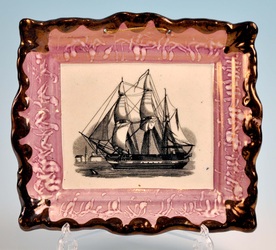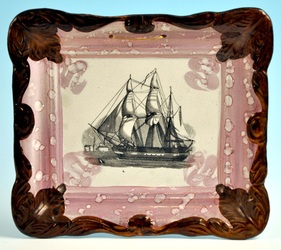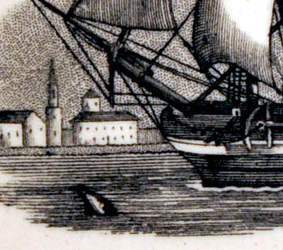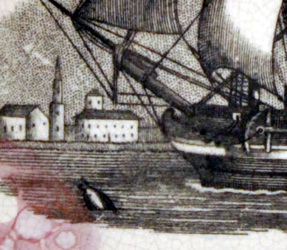|
7/31/2011 0 Comments More on Carr ship plaquesFirst of all, a quick note on my current preoccupation with John Carr. For the other major North East potteries that produced plaques – Dixon, Moore, Scott and Maling – we can form a picture of how their products changed through the 1830s, 40s and 50s (see the plaque dates page for an overview). But for Carr, there is a black hole. We know that Cornfoot, Colville & Co produced many pink lustre plaques between 1829 and c1832 at the Northumberland Pottery in North Shields. We know that from 1861 onwards, John Carr & Sons, on the same site (by then known as the Low Lights Pottery), produced pink lustre plaques – like the one with the impressed mark in my previous post. It seems a fairly safe assumption that throughout the period c1832–1861 the production of pink lustre plaques continued. The partnerships between those dates are (according to Bell): Cornfoot, Carr & Patton, 1834–1847 Carr & Patton, 1847–1848 John Carr, 1848–c1850 John Carr & Co, c1850–1854 John Carr & Son (note singular), 1854–1861 The plaques produced in the earlier partnerships would likely have been of higher quality than those produced from 1861 onwards. So perhaps Carr's finest plaques remain unattributed. Carr & Patton also took over the Phoenix Pottery, Ouseburn, in 1847. Bell writes that their partnership was apparently dissolved a year later, with John Carr continuing at the Low Lights Pottery and John Patton at the Phoenix Pottery. Separating their wares of the 1850s might be difficult, unless we can show that transfer plates continued to be used by the later Carr partnerships. The engraving below of the ship Marco Polo appeared in The Illustrated London News in 1853. And yet the plaque, attributed to John Carr's Low Lights pottery, was likely made in the 1860s. So did one of the earlier Carr partnerships make plaques using the same transfer during the 1850s? The smaller plaques with this transfer are amongst the most common of all the maritime plaques, and must have been produced in their thousands. How many of the potteries could have coped with such a large production run? But there are at least two variations of the transfer (discounting the modern reproductions titled Agamemnon). Look at the plaques below and their details, particularly the flags (click to enlarge and to move from one photo to another). The first two have a flag on the first mast, the third doesn't. The first two have seagulls flying around the masts, the third doesn't. Through tiny flaws in the engraving, I am certain the first two come from the same transfer plate. The third plaque is a low quality variation, produced in much smaller numbers. The transfer is over-glaze, and I suspect it was produced later than the other two plaques. Its dimensions are within a couple of millimetres of the first plaque. So the thousands of plaques out there like the first one above, were likely produced by John Carr & Co from c1853 when the engraving was published, and John Carr & Son after that. Those like the second plaque were likely produced by John Carr & Sons in the 1860s, when taste shifted to plaques with wider borders. The third plaque is late (maker unknown), but highlights the danger of making sweeping attributions without looking closely at the transfers. Click on the details of the two plaques below. Remember, every dot and line of shading was engraved by hand. These two plaques are clearly from the same transfer plate. As we'd expect, the transfer of 1860's plaque on the right shows evidence of wear. So the link between Carr and the plaques in group 2 of my previous post, I hope is clearly established. However, there are some very obvious differences between the 'Prepare' and 'Thou God' in group 2, and their 1860's counterparts. But I have a pile of shirts to iron, so the differences will have to wait for another post.
0 Comments
Leave a Reply. |
AuthorStephen Smith lives in London, and is always happy to hear from other collectors. If you have an interesting collection of plaques, and are based in the UK, he will photograph them for you. Free advice given regarding selling and dispersal of a collection, or to those wishing to start one. Just get in touch... Archives
February 2022
AcknowledgementsThis website is indebted to collectors, dealers and enthusiasts who have shared their knowledge or photos. In particular: Ian Holmes, Stephen Duckworth, Dick Henrywood, Norman Lowe, Keith Lovell, Donald H Ryan, Harold Crowder, Jack and Joyce Cockerill, Myrna Schkolne, Elinor Penna, Ian Sharp, Shauna Gregg at the Sunderland Museum, Keith Bell, Martyn Edgell, and Liz Denton.
|
